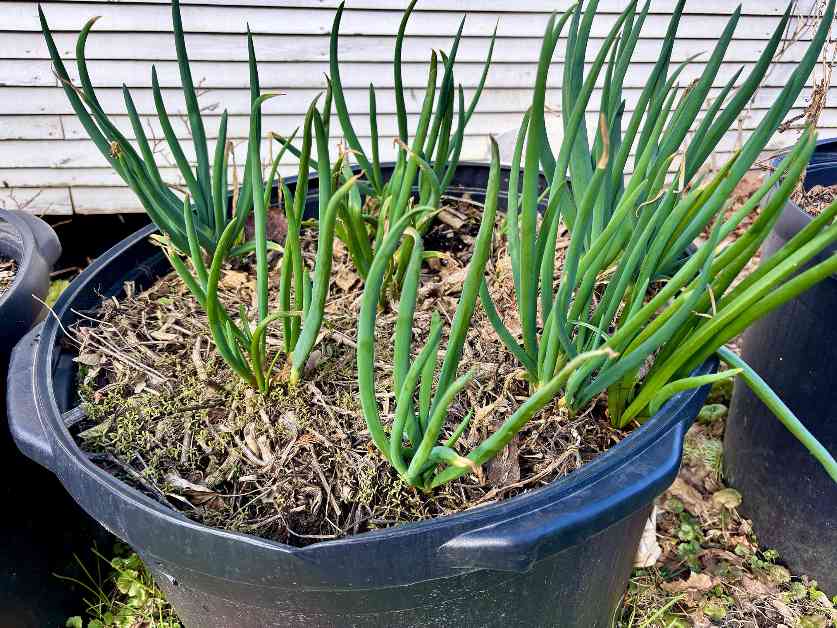Some activists champion turning lawns into vegetable gardens. That’s fine. I’ve sometimes recommended it myself. But lawns can be an irreplaceable amenity for families — for summer dining, recreation, crawl space for toddlers, etc. Without compromising these benefits, the lawn can also benefit the family vegetable plot. (If you manage your lawn to emulate a putting green, this article is not for you.) A lawn that is not only grass, but also features dandelions and ‘White Dutch’ clover, can provide fertilizer, mulch, and pest control to a nearby garden while improving the soil. In part, it can increase the soil’s ability to absorb water, which could be important in coming years of increased flood risk combined with less frequent droughts. Some of us find a stretch of green punctuated with vibrant yellow flowers beautiful, energizing our appreciation of spring. The dandelion, an invasive plant from across the ocean, also provides many other benefits. Their leaves are edible in spring when the garden is still trying to grow its own tasty, nutritious greens. As a boy, I recall both my grandmother of French Canadian extraction and her counterpart, of steely-eyed English Yankee extraction, agreeing on the importance of an early spring mess of dandelion greens in giving the family a “spring cleanout.” Discover magazine reports in “Dandelion May Have Distinct Health Benefits” that dandelion leaves have “anti-inflammatory, choleretic, and diuretic properties’ and are eaten … as a remedy for a wide range of maladies.” Other analyses mention useful amounts of several vitamins and assorted minerals. In short, cooked dandelion greens are very good for us. Since the soil at our Montpelier home has tested high in lead, we only eat the greens that volunteer in our constructed garden beds and containers. (Fortunately, dandelion seeds float through the air and plant themselves in our garden.) People with urban soils, or soils long used in conventional agriculture and orchards, should test for soil lead and arsenic. Growers once commonly used arsenate of lead as their primary insecticide. The poison was gradually phased out by the 1960s, but both arsenic and lead tend to resist leaching — they stay put in the soil. Since they are elements, they do not break down. While dandelion greens are mainly eaten in spring, later I commonly pull a few to mix with greens for stir-fries, so we get the nutritional benefits without noticeable bitterness throughout the growing season. Newer plants are far less bitter than older plants. When more dandelions volunteer in beds and containers than we will eat, I pull them, roots and all, and spread them on the surface as high-fertility mulch. Robert Kourik, in his highly useful book “Understanding Roots: Discover How to Make Your Garden Flourish,” rates dandelions high as ‘dynamic accumulators,’ concentrating high levels of nitrogen, phosphorus, potassium, and calcium. Deep taproots — what I call “organic crowbars” — contribute to dandelions’ excellent dynamic nutrient accumulation. They push through heavy or compacted soil that thwarts the roots of grasses and other plants. This enables rainwater to penetrate deeper, resulting in less runoff, and prepares the way for grasses and clover, in particular, to thrive. This can result in deeper friable soil and stronger plants that live with dandelions in the lawn. Dandelion flowers benefit many species of insects that visit them for pollen and nectar. Besides this general ecological benefit, many tiny and some not so tiny insects that live on the bounty of flowers in their adult states eat or parasitize garden pests in their larval stages. A surfeit of food near the garden for these “beneficials” can enable very good control of some pests. There is no one practice that suffices to control all potential garden pests, but available and attractive flowers providing pollen and nectar are an essential ingredient for truly effective organic pest control. (Small flowers, such as white alyssum or buckwheat, right in the garden can also be an important component in organic control of a wide variety of vegetable garden pests. Spiders and larger predatory insects such as hornets and wasps, are also important.) Part 2 of this article, to appear in a later issue of The Bridge, will cover the role of grass and clover in the nutrient cycle of the lawn. For more information, email permaculturemail@aol.com.
Enhance Your Vegetable Garden with Dandelions: Part 1
11
BREAKING NEWS
Tipster Receives $25,000 Reward for St. Johnsbury Police Shooting Case
Tipster Awarded Reward for Assisting in St. Johnsbury Police Shooting CaseIn a dramatic turn of events in St. Johnsbury, a tipster has been recognized...



















